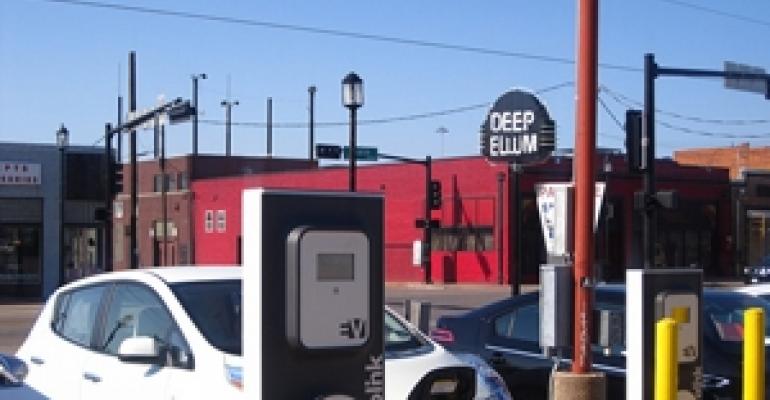
In the world of sustainability initiatives, providing charging stations for electric vehicles doesn’t provide the same bang for your buck as, say, energy-efficient lighting upgrades or super green HVAC systems. But property owners, managers and REITs are seeing the advantages to so-called EV stations and are installing them at office, retail, hotel and other commercial properties.
“REITs are always looking at how they can get a competitive edge, how they can strengthen their sustainability, how they can attract key tenants and how they can make their property more attractive to customers,” says Brian Koontz, national sales manager for ECOtality Inc. “This is one way to do that.”
KBS Real Estate Investment Trust II has 12 EV stations at three of its properties, Koontz notes, including six at Union Bank Plaza, a 40-story office and retail tower in Los Angeles.
In some cases, car-charging companies pay for installation and operation of EV stations and even allow property owners to take a cut of the revenue. Other companies work with government to provide subsidies. Often the tenant is the driver toward installing EV stations, but more and more property owners are leading the charge. There are also a wide variety of options for running the systems: Some connect to the common space electrical supply; others to that of an anchor tenant.
JBG Property Group worked with ECOtality and installed 28 EV stations at 14 different properties in the Washington, D.C. area—a mix of office, hotel and multifamily buildings.
“We are trying to explore a number of pilot projects to be a market leader in how we accomplish sustainability across the board,” says Eileen Nacev, vice president of sustainability for JBG, which has a $10 billion CRE portfolio. “We also wanted to be an early partner to help accelerate market expansion for alternative fuel vehicles.”

In 2009, the Department of Energy launched the EV Project, a program designed to expand and promote electric vehicle infrastructure nationwide. The DOE selected ECOtality to manage the program, which was launched with $230 million, half from the government and half from private entities.
Because the Washington, D.C. area did not have a wide distribution of EV stations, the EV Project covered about 90 percent of the initial installation costs, Nacev says. Depending on the physical layout of the location, some installations cost about $5,000 and some cost nothing. Nacev says she expects the company to install another dozen stations or so into this year and next. At the very least, the company breaks even on its expenses versus revenue from the EV stations. She also expects to make a profit from them eventually.
Simon Property Group, the mall giant, started putting in EV stations in April 2011 and now has 96 stations at 43 malls, including an Indiana system unveiled last month that runs partially through solar power.
“There is a thing called range anxiety, where a driver sees that battery going down and they don’t know where to recharge,” says George Caraghiaur, senior vice president of sustainability for Simon. “If people need to recharge, we want them to do it with us and shop.”
CarCharging Group Inc. has installed stations at about 40 Walgreens drug stores in Florida, Ohio, Georgia, Illinois, Texas and Massachusetts. The company also works with parking corporations and retail and mixed-use real estate companies. For multifamily giant, Equity Residential it has put in 16 stations at 10 properties; at Federal Realty Investment Trust, CarCharging installed four stations at four locations.
At JBG Properties, Nacev says any new parking construction in the company’s portfolio will be done with EV stations in mind when it comes to configuring electrical wiring and internet connectivity. “I think it’s just going to be part of the norm,” she says.
Plenty of data shows that EV drivers are good for business. ECOtality’s Koontz notes that a traditional driver might return to a location once a quarter; an EV driver comes back once a month. An average customer visits a location for 45 minutes while an EV driver stays twice as long, he says.
Simon’s Caraghiaur says the average stay by EV drivers at the company’s top ten charging locations is almost two hours. And the stations are generally busy. At one California property, about 1,400 vehicles charged over about nine months last year.
And there are other benefits. Koontz says installing EV stations can often be used to get LEED program points. It’s also a way to attract big box tenants who want to use the charging stations as part of their own sustainability pushes. “I think some REITs see this as an amenity at a property that will become just as routine as a fountain or an ATM machine,” he explains. “It’s that or they will just see it as an upgrade to keep up with the times.”

